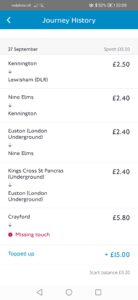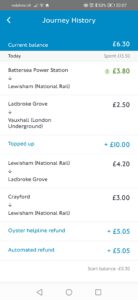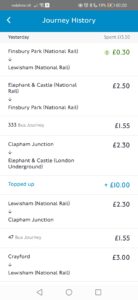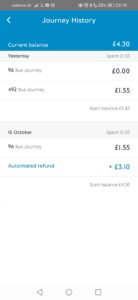First published on 30th September, updated on 6th and 12th October.
With the new system of capping starting this week I decided that now was a good time to dust off my Oyster card and check out how things work. Whilst the behind the scenes processing seemed reasonably clear, I wanted to see how much explanation TfL provided when adjustments were made. There is also the unanswered question of what will happen if the card isn’t used for several days when an adjustment has been queued.
 The picture shows my journey history on Monday 27th September. Straight away you’ll notice that I had a missing touch on the first journey. This was a schoolboy error as I hadn’t put my usual credit card out of normal reach and I managed to touch out at Kings Cross St Pancras using that instead of the Oyster. With the benefit of hindsight that turned out to be a master-stroke, because it exercised little used parts of TfL’s system, but more on that later.
The picture shows my journey history on Monday 27th September. Straight away you’ll notice that I had a missing touch on the first journey. This was a schoolboy error as I hadn’t put my usual credit card out of normal reach and I managed to touch out at Kings Cross St Pancras using that instead of the Oyster. With the benefit of hindsight that turned out to be a master-stroke, because it exercised little used parts of TfL’s system, but more on that later.
The idea for this day was to make one journey from zone 6 into zone 1, then several journeys in zones 1-2 such that the zones 1-2 cap should apply. The Oyster would continue charging up to the zones 1-6 cap but the difference would be adjusted overnight. To make this happen I used my credit card to return from Lewisham so that there was only one extension fare to pay on the Oyster.
On Tuesday evening I called up the helpdesk to get rid of the incomplete journey on my credit card. The agent was happy with my explanation and was also happy that I’d correct the Oyster journey myself. I entered Kings Cross as the end point for the first journey and received an email confirming my application with a further email to be sent within 24 hours with the outcome.
By Wednesday lunchtime I hadn’t received any further emails so I decided to go and try to touch in with my Oyster card which had -£0.30 as the balance. Imagine my surprise when not only did the gate open, but the balance was reported as £9.80, a lot higher than expected.
 I boarded the train and then logged on to see what was happening. Yes, that’s two identical refunds, one described as “Automated refund” and the other as “Oyster helpline refund”. It appears as though my amended journey history went through the automated process and with an adjustment greater than £1.50 it queued a refund. But the action of resolving the missing touch sent my details to be reviewed and the helpdesk also raised a refund. Result! Full disclosure: TfL are aware because it looks like they may have to adjust their processes in the future.
I boarded the train and then logged on to see what was happening. Yes, that’s two identical refunds, one described as “Automated refund” and the other as “Oyster helpline refund”. It appears as though my amended journey history went through the automated process and with an adjustment greater than £1.50 it queued a refund. But the action of resolving the missing touch sent my details to be reviewed and the helpdesk also raised a refund. Result! Full disclosure: TfL are aware because it looks like they may have to adjust their processes in the future.
Was the £5.05 adjustment correct though? Yes it is. My charge should have been a £7.40 zone 1-2 cap plus a £3.05 zone 3-6 National Rail extension fare. That’s a bit naughty really because the normal fare is £3.00, but the train companies want the zone 1-2 cap plus two extensions to equal the zone 1-6 cap. However, that’s an argument for another day. £15.50 came down to £10.45 which is what would be charged initially if a contactless card had been used.
For Wednesday I wanted to see the effect of breaking the extension journey at Lewisham which is a zone 2/3 station. As mentioned in an earlier article, Oyster will start a new journey if you touch out and in again at the same gateline, but contactless joins the two journeys together because it applies the same station OSI whether or not different gatelines have been used. You can see that at the end of the day I have capped at the zone 1-6 cap and we’ll see what adjustment is generated this time.
My biggest disappointment is that I have had no email explaining what the adjustment is for, how it has been calculated, or even that it exists at all. I’ll be trying out leaving collecting an adjustment for longer than the 3-day faster universal load duration in due course, but I’m hoping that there might be some communication in that instance.
Part 2
 An unexpected issue meant that I couldn’t go out as planned before this Monday. Never mind I thought, at least this should mean that the initially queued refund from Thursday will have dropped off the main Faster Universal Load queue and I’d have to reactivate it by starting a journey. Whilst walking to the bus stop I passed Crayford station and I touched the card on the ticket machine so I could check the balance. There was £6.30 on the card, so no need to topup first.
An unexpected issue meant that I couldn’t go out as planned before this Monday. Never mind I thought, at least this should mean that the initially queued refund from Thursday will have dropped off the main Faster Universal Load queue and I’d have to reactivate it by starting a journey. Whilst walking to the bus stop I passed Crayford station and I touched the card on the ticket machine so I could check the balance. There was £6.30 on the card, so no need to topup first.
I boarded the 96 bus and carefully looked at the reader to see what it said. I was not expecting £7.80 to be displayed as that meant that the refund had been added immediately. I can think of three possible reasons why that happened: (a) the touch on the ticket machine triggered the re-queue; (b) the original queuing had not expired within the expected three days; or (c) the journey history was run through the back office again because the week had ended and as I hadn’t collected the earlier adjustment it was re-queued, cancelling the entry from the second list. My instinct says that (a) is unlikely, (b) is possible but still not that likely, so it’s probably (c). I’m awaiting confirmation from TfL.
The amount of the adjustment was a little disappointing. I’d made one zone 3-6 journey of £3.00 before making lots of journeys within zones 1-2. In my view that meant that I should have paid £7.40 for the zone 1-2 cap and £3.00 for the initial journey meaning that £3.10 was due back. However, the back office saw touch out and back in again at Lewisham NR and decided to join the two journeys together, even though the same gateline had been used. Thus the zone 3-6 journey became a zone 1-6 journey and an extension fare of £3.05 was charged instead. It’s not TfLs fault that the train companies want the extra 5ps, but it is annoying that the back office doesn’t seem capable of differentiating between the gatelines at the station.
 And so to Tuesday. No adjustment to pick up this time, but I’m determined that I’m keeping the extra 10p this time. As previously the last journey from Lewisham to Crayford is done using my bank card so that is guaranteed to be just the journey fare. On arrival at Lewisham first time round I seek out a bus. I’m going to cap so the extra £1.55 will just contribute to that. But touching in on the bus, and getting off straight away, means that there is no way the system will join the two rail journeys at Lewisham. [Most bus drivers are aware of the break an OSI trick so they don’t even bat an eyelid when you get off again.]
And so to Tuesday. No adjustment to pick up this time, but I’m determined that I’m keeping the extra 10p this time. As previously the last journey from Lewisham to Crayford is done using my bank card so that is guaranteed to be just the journey fare. On arrival at Lewisham first time round I seek out a bus. I’m going to cap so the extra £1.55 will just contribute to that. But touching in on the bus, and getting off straight away, means that there is no way the system will join the two rail journeys at Lewisham. [Most bus drivers are aware of the break an OSI trick so they don’t even bat an eyelid when you get off again.]
The next part of the trip involved checking out a weird charge when travelling from Clapham Junction to Elephant & Castle LU using the OSI between Queenstown Road and Battersea Power Station. The fare finder has a variety of fares, but via Battersea Power Station is not one of them. This means that it should have charged the default fare of £2.50 which is a TfL-LU zone 1-2 off-peak single. [TfL-LU includes most Overground journeys so this assumes a journey via West Brompton and Monument/Bank.] What it actually charged was £2.30 which is a zone 2 NR1+T fare. This is one of the alternative fares which describes travel via Vauxhall and Stockwell. But I didn’t go via Vauxhall so that fare shouldn’t be charged. I’m not sure what’s going on here.
Finally I went to Finsbury Park to check out the situation now the one-way system has gone. It’s just as confusing as it was before the pandemic, but more on that later. At the moment I’ll probably try to pick up the adjustment on Sunday, without using the ticket machine to check the balance and before the end of the Monday to Sunday week.
 Part 3
Part 3
Not much to report this time round. I did manage to pick up the adjustment on Sunday and it was still queued to be picked up immediately. I think this means that the refund remains live for at least 5 days. I’m also confident that the touch on a ticket machine didn’t cause the unexpected behaviour last week, and it’s likely that there isn’t a re-queue at the end of the Monday to Sunday week either.
On the positive side, the adjustment was for £3.10, so the bus touch in at Lewisham worked as expected to split the first journey there – good to know some things still work as intended.
Conclusions
The system appears to work pretty much as designed. It feels slightly wrong to overcharge people and then refund them later on, but this is probably the best workaround given the constraints of the system. The biggest stumbling block as I understand it was providing people with a journey cost and balance at every touch out. This couldn’t be done if the master record of travel was the central system. This meant that people might inadvertantly travel without funds, which might be difficult to recover after the event.
The one drawback in my opinion is the lack of any documentation as to what the refunds are for, or indeed that one is available. Obviously if you’re using an unregistered Oyster card then you’ll just have to accept what you get, but where TfL have an email address it would be good to let the passenger know what’s happening.
I’m not convinced that the mechanism by which your double refund came about is as you describe. It is, as you say, a process flaw but I think it happens when the help desk gives a refund manually for a missing touch and then the user subsequently enters the missing touch and the auto refund system then corrects the same journey. The flaw being that the auto mechanism has no way of knowing that the already manually applied refund relates to the missing touch it is about to correct. I know you said to the agent that you would sort out the correction yourself but I suspect they nevertheless applied a refund. I think this flaw has been there since the ability for a user to add missing touches was added.
Hi Simon,
Thanks for your thoughts. The one detail I didn’t specifically make clear was that I supplied the missing touch to the Oyster journey while I was speaking to the agent who was refunding the contactless charge. I certainly confirmed to him that the opportunity to resolve a journey had disappeared and may even had said that I’d had the email. In those circumstances I’d be surprised if he went on to process the refund again.
I know from personal experience that TfL is quite generous with refunds, years ago I had an unresolved journey that required resolving through calling to the hotline, and it resulted in doubling the refund.
And as I recalled, the unresolved journey was due to the same card mishmash reason…
Agreed, they have historically been quite generous. They have tightened up more recently though.
I’ve certainly also been refunded twice on Oyster through the helpline and automated before the weekly capping came into effect.
I should really use PAYG as I’m sure I spend less than the Bus & Tram Pass price, but I don’t like the anxiety of having to keep checking my balance as I did recently when I used PAYG on Oyster with the B+T Photocard expiring with less than a week left on it. (I use Google Pay for rail journeys).
Weekly bus capping has been a thing on Oyster for a while now, or is your bus and tram pass a longer duration? Plus when you make rail journeys the bus journeys would also count towards daily capping for them. Or am I missing something?
It’s a weekly pass. I didn’t realise weekly capping was already in effect.
I don’t use my Oyster for rail journeys, I use Google Pay for rail journeys purely for convenience.
Yes, weekly bus capping came in last year. It’s also a thing on contactless so I don’t see the attraction of using different systems for both. Bus journeys count towards both the bus only caps and the overall daily/weekly caps. You might end up paying more than you need some days.
Hi, weekly bus capping often doesn’t work on Contactless. It’s fine if you ONLY make bus journeys, but if you also do tube journeys, it continues to charge full £1.55 for buses even if you’ve exceeded the £21.90 bus cap – it continues charging until you hit the relevant weekly Travelcard cap, even if you’ve only taken a couple of tube journeys. It’s a pain having to call TfL every time this happens. They do give refunds, but can’t explain why it isn’t calculating correctly – today I got a “well done for spotting the mistake” – frankly most people wouldn’t have spotted it, so I wonder how much TfL is overcharging everyone…
Hi Kien,
Thanks for the tip off. I’ll follow through on that.
I travelled yesterday at 13.41 with my oyster PAYG [Senior Railcard added to Oyster Card] from Kensal Rise to Dartford and have been charged £4.25 when I never touched Zone 1. I used the pink validator at Clapham Junction then travelled to Denmark Hill and then on to Dartford. Would I be due any refund £1.20 or to obtain the lower fare or would I have to travel via West Hampstead-West Hampstead Thameslink. I choose the route that I took as it’s much easier to to navigate with the stairs and saves going out to street level at West Hampstead.
Hi Len,
First point to note is that there are no avoiding zone 1 fares for this journey. The cheaper via West Hampstead route is because it doesn’t use the Underground. The train companies seem to believe that the number of changes required for your route means hardly anyone will use it. They also don’t sell paper tickets avoiding zone 1 and that would be needed before TfL could add the new fare.
You can get a cheaper than £4.25 fare for this journey, but it requires touching out and back in again somehwere between Clapham Junction and Peckham Rye. This would make two journeys costing £1.00 and £2.30. All prices off-peak with railcard.